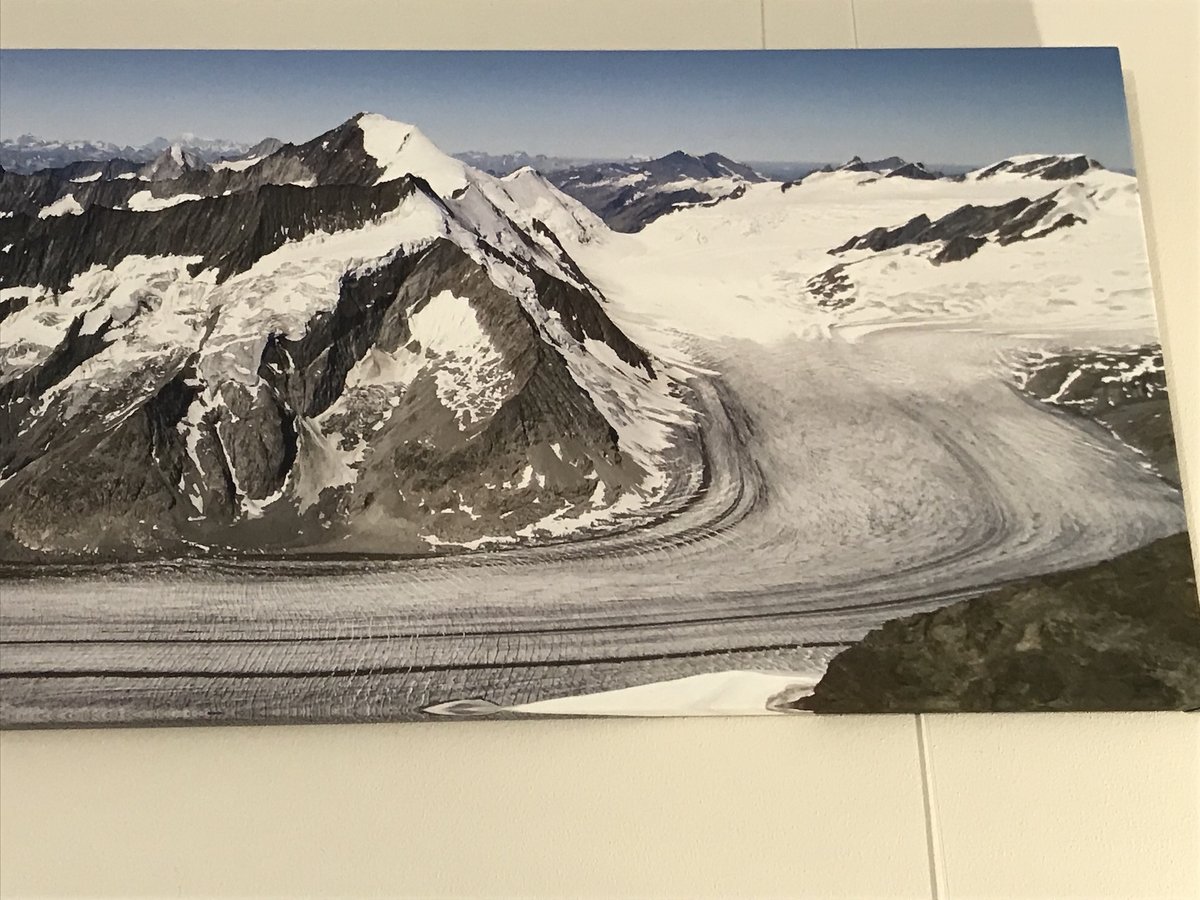
Photo: Every day, a large photo of the Aletsch glacier at a wall of my office reminds me of the core of my work. Maybe that’s why this documentary has made such a deep impression on me.
A bit of a shock
I don’t know whether it was shock, admiration, curiosity, or a combination of emotions, but I had to find out more about this. A German documentary showed a new cable car station in a ski area near the Aletsch Glacier in Switzerland. The cable car can be adjusted to movements of the mountain so that the safety of tourists in the gondolas is not compromised. The mountain is subsiding in response to the retreat of the Aletsch Glacier. Naturally, the height of the cables must remain stable. Hydraulic cylinders under the cable car station ensure this. Unique in the world.
Consequences of retreating glaciers
Glaciers are retreating rapidly due to global warming, and the loss of glacier ice is destabilising the slopes of the glacier valleys. Two causes for this destabilisation are mentioned in the scientific literature. One of these is the loss of support – debuttressing – of oversteepened valley flanks, causing landslides and rockfalls. The other is the exposure of rock slopes – after glacier retreat – to variations in surface temperature and pore pressure, which increase fractures and cracks inside the rocks. The Aletsch Glacier, the longest glacier in Europe with a length of nearly 22 km and a maximal depth of 900 m, is one of those rapidly retreating glaciers. The Moosfluh is a mountain area near this glacier that is part of a large ski area and is subject to a large landslide and frequent rockfalls.
More dramatic
The landslide in this area is nothing new. It is a phenomenon that has been changing this area at a very slow pace in recent decades. At the end of the previous century, the average annual displacement rate of the landslide was less than 1 cm per year. At the end of the 1990s, however, the situation changed. The displacement rate accelerated to a velocity of up to 10 cm per year, reaching values of more than 1 m per year in 2011, probably due to an acceleration of glacier retreat. More dramatic changes occurred in the fall of 2016, when displacement rates further increased, even up to values exceeding 5 m displacement in one week in October 2016.
In addition to the acceleration of the landslide, rockfalls within the landslide at the foot of the slope increased in frequency and volume. Before 2005, only one single rockfall event with a volume of ‘only’ 5,000 cubic metres was recorded. Between 2011 and 2012, seven rockfalls were recorded, and in 2016, 2.5 million cubic metres broke off in a single incident. Geologists always assumed that the process of slope destabilization was slow and barely noticeable. The developments in the last two decades caught the experts by surprise.
The landslide is progressively moving upslope, up to the mountain ridge that forms its upper extension – which is subsiding as a result. This is the ski area with the innovative, adjustable cable car station.
And the ski area?
Whenever the mountain moves and slips away a bit, the cable car station can compensate for this – by up to eleven meters. The cable car rests on a huge concrete tub. Inside, 15 hydraulic cylinders can push up the huge metal structure including ropes and gondolas, and ensure that the infrastructure continues to function and that the tourists can continue to ski safely here. The cylinders have already pushed up the cable car station by almost three meters in the last eight years.
A bit puzzled
I am still a bit puzzled and not quite sure what to think about this. I admire the innovative thinking and the courage of the Swiss. Still, I feel uneasy when I realise that the answer to a retreating glacier and a sliding mountain is a cable car station that can be adapted to the movements of the mountain. As if the loss of the glacier is less dramatic as long as we can still ski.
And what about the future? It is unclear whether the events in recent years will continue at such a high pace in the future. But the landslide and rockfalls will continue because the glacier will continue to retreat. And the Swiss will keep on adapting to this situation: a new cable car, which can also be moved, will soon be built on a summit in the area.
Sources:
Kos et al., 2016. Contemporary glacier retreat triggers a rapid landslide response, Great Aletsch Glacier, Switzerland. Geophysical Research Letters 43: 12,466-12,474.
Storni et al., 2020. Monitoring and analysis of active rockslide-glacier interactions (Moosfluh, Switzerland). Geomorphology 371: 107414, doi: 10.1016/j.geomorph.2020.107414.








